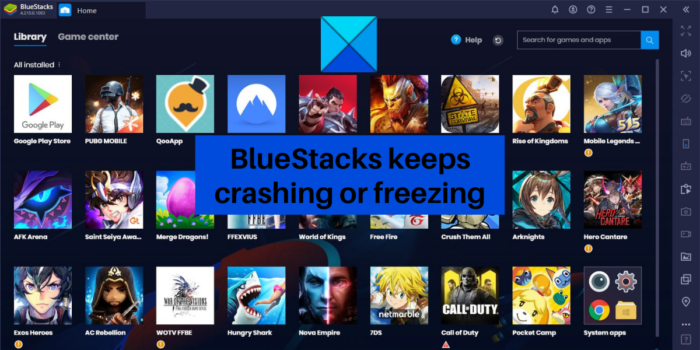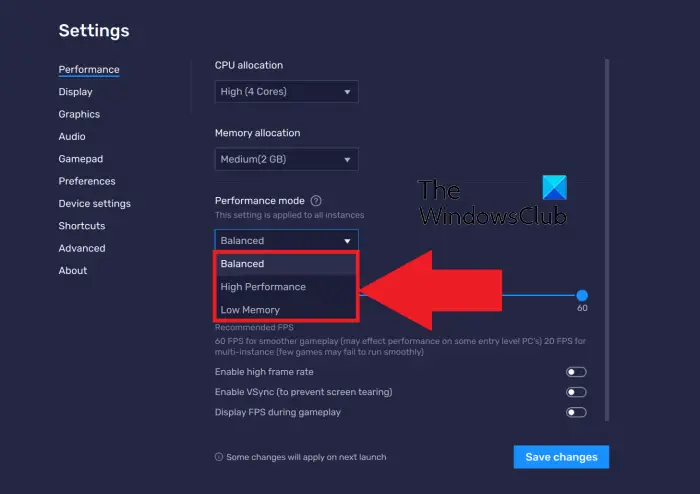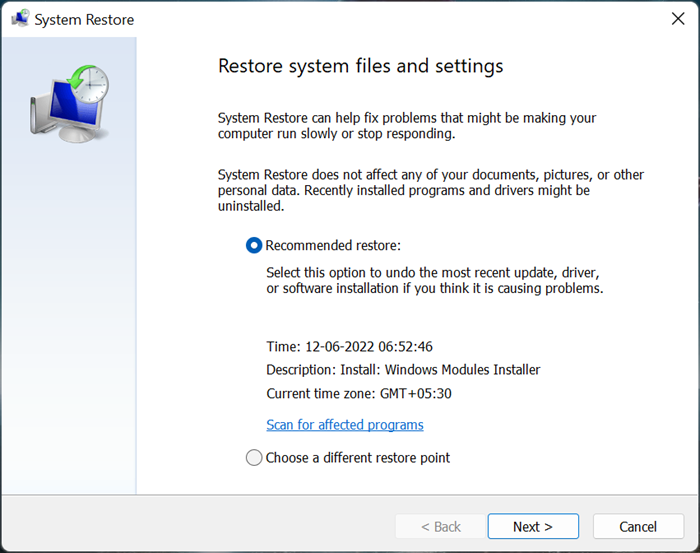Does BlueStacks keep on crashing or freezing on your Windows PC? Here is a complete guide on how you can fix BlueStacks’ crashes and freezing issues on Windows 11/10.

BlueStacks is one of the most popular android emulators for Windows. It enables you to run android games and apps on a Windows PC. However, a lot of BlueStacks users have complained that the app keeps on crashing on their PC. While for some users, the application crashes in mid-way, some users experience crashes at startup. Many users even complained that the app gets frozen in the middle which makes it unusable. Now, these issues could be caused because of several reasons. Let us check out these reasons.
Why does BlueStacks keep crashing or freezing on PC?
Here are the potential causes that BlueStacks keeps crashing or freezing on Windows PC:
- If BlueStacks settings are misconfigured, you are likely to experience the issues at hand. Hence, set up the application settings including the Performance and Graphics settings of BlueStacks to fix the problem.
- Outdated display drivers are likely to cause performance issues with BlueStacks. So, you need to ensure that your graphics drivers are up-to-date and you are using their latest version.
- If there are too many programs running on your system, BlueStacks might crash or freeze or lag because it requires a good amount of RAM. Hence, if the scenario is applicable, you can close all the background applications to free up some RAM and fix the problem at hand.
- Hyper-V causes issues with BlueStacks and if enabled, the app might not even open. So, disable Hyper-V using Control Panel, PowerShell, or Command Prompt and see if the problem is resolved.
- In case the installation files of BlueStacks have gone corrupted, BlueStacks won’t function properly on your system and is likely to crash or freeze. In that case, you can uninstall and then reinstall BlueStacks to fix the issue.
Based on the above scenarios, you can apply a suitable fix. But, before using a solution, check the recommended system requirements to run BlueStacks and see if your PC meets them or not.
Recommended System Requirements for BlueStacks:
- OS: Windows 10 and above
- Processor: Intel or AMD Multi-Core Processor with Single Thread benchmark score > 1000
- Graphics: Intel/Nvidia/ATI, Onboard or Discrete GPU with benchmark score >= 750
- RAM: 8GB or higher
- Storage: SSD (or Fusion/Hybrid Drives)
- Internet: Broadband connection.
- Additional notes: You must be an administrator on your PC, Make sure Virtualization is enabled on your system.
BlueStacks keeps crashing or freezing on Windows PC
Here are the fixes you can use if BlueStacks keeps crashing or freezing on your Windows 11/10 PC:
- Modify BlueStacks configurations.
- Update GPU drivers.
- Terminate non-essential programs.
- Disable your antivirus.
- Turn on Virtualization in BIOS.
- Disable Hyper-V.
- Update/ Reinstall BlueStacks.
- Perform a system restore.
1] Modify BlueStacks configurations

You can try adjusting your BlueStacks settings to fix crashes. BlueStacks requires a high-end computer as it is a graphics-oriented app. But, if it keeps crashing or freezing even on a high-end PC, there are high chances that not enough RAM and CPU cores are allocated for the program. Hence, if the scenario is applicable, you can modify your BlueStacks configurations. Here’s how you can do that:
- Firstly, open the BlueStacks application and press the gear button to bring up its Settings window. You can also press the Ctrl + Shift + I shortcut key to open the settings.
- Now, in the Settings window, go to the Performance tab.
- Next, under the CPU allocation option, select High (4 cores), set Memory allocation to High (4GB), and choose High Performance for Performance mode.
- After that, move to the Graphics tab and change the settings as follows:
Graphics Engine: Performance
Graphics Renderer: OpenGL
Interface Renderer: OpenGL
GPU Settings: Prefer dedicated graphics (NVIDIA only)
ASTC: Hardware decoding
ASTC textures (Beta): Software decoding - Finally, click on the Save changes button to apply new settings.
You can now use BlueStacks and see if it still crashes or freezes. If yes, you can move on to the next potential fix to resolve the issue at hand.
Read: BlueStacks is stuck on Starting the Engine screen.
2] Update GPU drivers
As BlueStacks is a graphics-oriented application, you must have up-to-date and clean graphics and display drivers. An outdated and faulty GPU driver is likely to cause BlueStacks to crash or freeze. Hence, if the scenario is applicable, update your graphics driver to its latest version and then try using BlueStacks to see if the problem still persists.
The easiest way to install graphics driver updates on Windows 11/10 is to use the Settings app. You can follow the below steps to update GPU drivers:
- Firstly, hit the Windows + I hotkey to launch your Settings app.
- Now, click on the Windows Update tab and tap on the Advanced options > Optional Updates option.
- Next, you will be able to view all the optional updates including device driver updates. You can download and install all the pending device driver updates.
- Once done, reboot your PC and check if Bluestacks still crashes/ freezes or not.
There are multiple other methods using which you can update GPU drivers. You can visit the official website of the device manufacturer like Intel, NVIDIA, or AMD. Then, search for your graphics driver and download the most recent installer for your driver. Once done, run the installer and follow the prompted instructions to complete the driver installation.
You can also download and install a free third-party driver update software like Winzip Driver Installer, IObit Driver Booster Free, etc. These software help you automatically update all your out-of-date device drivers. So, it is easy and convenient.
If the problem still persists with an up-to-date graphics driver, there might be some other underlying reason causing BlueStacks to crash or freeze. Hence, move on to the next potential fix to resolve the issue.
See: BlueStacks stuck on Initializing screen on Windows 11/10.
3] Terminate non-essential programs
BlueStacks requires a lot of RAM and other system resources. If you have too many applications opened and running in the background, it is likely to deteriorate the performance of BlueStacks and cause it to crash or laggy and become unusable. Hence, if the scenario is applicable, close all the non-essential programs and then see if the problem is resolved.
To do so, you can open your Task Manager using the Ctrl+Shift+Esc hotkey. Now, from the Processes tab, select a running process and then press the End task button to close the respective program. Repeat this process for all other unused applications running in the background. Once done, reopen BlueStacks to check if the application runs without crashing or freezing.
In case the problem still persists, we have some more fixes that you can use to resolve it. So, move on to the next solution.
Read: Snapchat not working on BlueStacks Emulator on Windows 11/10.
4] Disable your antivirus
The next thing you can try is disabling your antivirus to fix the issue. There is a possibility that your third-party antivirus suite (Avast, Bitdefender, Norton, Malwarebytes, etc.) is interfering with the BlueStacks application and affecting its working. As a result, BlueStacks keeps crashing and freezing. So, if the scenario applies to you, disabling your antivirus should fix the issue for you.
Sometimes, disabling antivirus might not work. Hence, you will need to uninstall your antivirus software for the time being. Just open the Settings app using Win+I and go to Apps > Installed apps. Next, select your antivirus app and click on the three-dot menu button. After that, click on the Uninstall option and follow the onscreen instructions to uninstall it. Once done, reboot your PC and run BlueStacks to check whether it still crashes or freezes.
If you still face the same problem, move ahead and use the next potential fix.
RELATED: How to speed up BlueStacks for faster Android emulation?
5] Turn on Virtualization in BIOS
You can try enabling Virtualization in your BIOS settings to make your PC run faster. This might fix BlueStacks crashes and other performance issues. To check whether Virtualization is enabled or not, open Task Manager by pressing Ctrl+Shift+Esc. And then, go to the Performance tab, and under the CPU section, check for the Virtualization option and see if it is Enabled or Disabled. If it is disabled, you can enable Virtualization via the BIOS settings. In case this doesn’t help, move on to the next potential fix to resolve the issue at hand.
6] Disable Hyper-V
Hyper-V is known to cause issues with android emulators for PC including BlueStacks. There also have been reports where users complained of getting the BlueStacks cannot start when Hyper-V is enabled error. So, disable Hyper-V and reboot your PC to check if the problem is still there. Here’s how to do that:
- Firstly, launch Command Prompt as an administrator.
- Now, enter the below command:
bcdedit /set hypervisorlaunchtype off
- Once done, restart your PC and launch BlueStacks to check if the issue is resolved.
There are other ways to disable Hyper-V in Windows including Control Panel, PowerShell, and Registry Editor. If this method doesn’t help, move on to the next potential fix.
See: How to uninstall a game or an app in Bluestacks?
7] Update/ Reinstall BlueStacks
You need to make sure that you are using the latest version of BlueStacks. If you have an outdated version of BlueStacks, you might face performance issues like crashes, freezing, etc. Hence, update BlueStacks to its latest version.
If you have installed all the available updates for BlueStacks and still facing the same issues, you might be dealing with a corrupted installation of the app. Hence, reinstall the latest version of BlueStacks and see if the problem is resolved.
For that, first, uninstall BlueStacks completely from your PC using the Settings app. First, hit Win+I to launch Settings and move to Apps > Installed apps. From the apps’ list, select BlueStacks and tap on the three-dot menu button. Next, choose the Uninstall option and follow the onscreen instructions to uninstall it. After that, visit the official website of BlueStacks and download its latest version. Then, install the application on your system and launch it to check if it has stopped crashing and freezing.
In case you still face the same issue, we got one more fix for you. So, move on to the next potential solution.
8] Perform a system restore

If none of the above solutions worked for you, the last resort to fix the problem is to perform a system restore. If you just recently started facing crashes in BlueStacks, there is a high chance that there is some corruption in your system causing the issue at hand. Hence, you can try restoring your PC to a previous state where BlueStacks was functioning properly using a system restore point.
Here’s how you can do that:
- Firstly, press Windows+ R to evoke the Run command box, type rstrui in the Open field, and press the Enter button to launch the System Restore wizard.
- Now, click on the Next button and then check the Show more restore points option to get a full list of system restore points.
- After that, choose a system restore point of the date when BlueStacks was working fine.
- Next, press the Next button and then click on the Finish button to complete the process.
- Your PC will now be rebooted to the previous state that you have selected.
You can now launch BlueStacks and hopefully, it won’t crash or freeze anymore.
How do I fix BlueStacks from freezing?
To stop BlueStacks from freezing, configure BlueStacks settings and optimize your configurations. Furthermore, you can update your graphics drivers, close unnecessary background applications, disable Hyper-V, enable Virtualization in BIOS, etc. If these fixes don’t help, you can reinstall a clean version of BlueStacks or perform a system restore. These fixes are discussed in detail in this post, so check them out.
Now read: Windows Subsystem for Android vs BlueStacks.
Leave a Reply